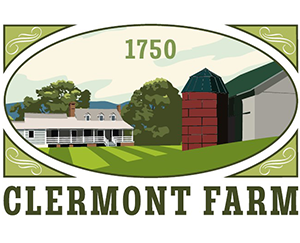Clermont Farm Receives $747,875 National Park Service Grant
The Clermont Foundation has received a grant from the National Park Service of $747,875 to rehabilitate the interior of the Owner House, five service buildings, and five historic structures at the farm. A funding match of $30,799 from the Foundation brings the total cost of the project to $778,674.
The 362-acre Clermont Historic Site, on the east side of Berryville, was surveyed by an 18-year-old George Washington in 1750. Bequeathed by Judge Elizabeth Williams at her death in 2004 to the Virginia Department of Historic Resources, the site is operated and funded by the Clermont Foundation, a local non-profit which she also established. Williams’ family had owned the farm for 185 years.
The four-year grant, 2025-29, “Multi-Structure Rehabilitation at Clermont Farm”, is a Semiquincentennial grant from the Historic Preservation Fund Competitive Grants Program administered by the National Park Service, Department of the Interior.
Unknown to many, the source of the funding for the Historic Preservation Fund and for this grant is not tax dollars, but Outer Continental Shelf oil and gas lease revenue.
The Semiquincentennial grants are in honor of the 250th birthday of the United States in 2026, and are awarded to sites associated with and illustrating the founding of the nation.
Clermont was a frontier farm first settled in 1742, and its first four owners were friends and associates of George Washington, both during his formative ten years, 1748-58, on the frontier in Frederick County (then including Clarke) and later during the Revolution and its aftermath.
The Clermont house was built in 1755-56 by Thomas Wadlington, who had surveyed with Washington and was a fellow parishioner at Pohick Church in Fairfax. The Clermont house was built at the same time as Washington began the construction of Fort Loudoun in nearby Winchester. Wadlington sold leather to Washington (as Col. of the Virginia Regiment) for moccasins for his Indian allies at the Fort. All five of Wadlington’s sons served in the Revolution.
Clermont’s next owner (1770-90) was Edward Snickers, for whom “Snickers Gap” (Rt. 7 on the Blue Ridge) is named. Snickers was a paymaster (advancing his own funds) and commissary to the Virginia Revolutionary troops. He was also Washington’s “man of business” west of the Blue Ridge. During the Revolution, Washington offered Snickers the Wagonmaster Generalship of the Continental Army, but Snickers declined due to age and continued his logistical role.
Clermont is still a working farm: beef cattle, sheep, and corn. It works closely with school programs and other regional education, agricultural, and conservation organizations. The Clermont Historic Site is open for public events and monthly on Third Saturdays (see website www.clermontfarm.org , call 540-955-0102), and by appointment.
